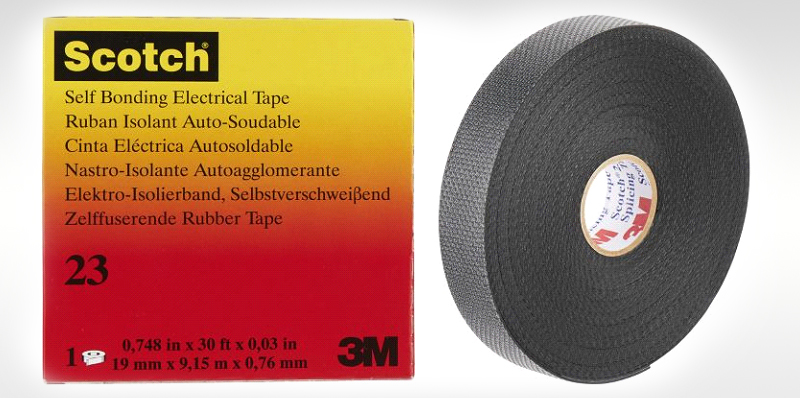Product Description
Scotch™ 23 Electrical Tape is a highly conformable self-fusing EPR (Ethylene Propylene Rubber) based, high voltage splicing tape. It is a non-vulcanising, shelf-stable tape with excellent electrical properties. 23 Tape can be used as an insulation for low-voltage applications as well as an insulation for splices up to 69kV. Tape Features ™ Can be used to splice and terminate cables whose emergency overload temperatures can reach 130°C. ™ Based on Ethylene Propylene Rubber (EPR). ™ Physical and electrical properties are unaffected by the degree of stretch. ™ Self-fusing tape. ™ Excellent electrical properties. ™ A special polyester liner which will not stick to the tape upon unwind. ™ Compatible with all solid dielectric cable insulation:- Polyethylene (high and low density). Cross-linked polyethylene (XLPE). Polyvinyl chloride (PVC). Butyl rubber. Ethylene Propylene Rubber (EPR). Oil-based rubber.Applications ™ Primary electrical insulation for splicing cable from 600V to 69kV on all solid dielectric cables. ™ Primary insulation for building stress cones on cables up to 35kV on all solid dielectric cables. ™ Jacketing on high-voltage splices and terminations. ™ Moisture sealing electrical connections. ™ Bus bar insulations. ™ End sealing high-voltage cables. Data - Typical Properties Physical Properties Test Method Typical Value* Colour Black Thickness ASTM-D4325 0.76mm Tensile Strength ASTM-D4325 1.4KN/m Ultimate Elongation ASTM-D4325 1000% Operating Temperature 90oC (194oF) Emergency Operating Temperature 130oC (266oF) Fusion, ASTM-D4388 Passes Thermal Conductivity 0.1208 Btu ASTM-D1518 (hr)(sq ft) (oF per ft) Modulus @ 130oC See Section 5 Ozone Resistance ASTM-D4388 Passes Electrical Properties Test Method Typical Value* Dielectric Strength ASTM-D4325 After Standard Conditioning 31.5 MV/m After 96 hours @ 96% RH >90% of Std Condition Value Insulation Resistance ASTM-1000 (Indirect method of electrolytic >1 x 106 corrosion) megohms Dissipation Factor See Section 5 Dielectric Constant See Section 5 Dielectric Strength at elevated temperature See Section 5 *This data is not to be used for specification. Values listed are for typical properties and should not be considered minimum or maximum. Specifications Product The high-voltage corona-resistant tape must be based on ethylene propylene rubber and be capable of operation at the emergency cable temperature of 130oC (266oF). The tape must be capable of being applied in either the stretched or unstretched condition without any resulting loss in either physical or electrical properties. The tape must not split, crack, slip or flag when exposed to various environments (indoor and outdoor). The tape must be compatible with all synthetic cable insulations.
The tape must have a dissipation factor of less than 5% at 130oC (266°F) and must have a shelf life of 5 years. Engineering/Architectural Specification Splicing and terminating solid dielectric cables shall be done in accordance with drawings engineered by the splice material manufacturer such as the 2047 series available from 3M Company. All splices and terminations shall be insulated using Scotch™ Brand 23 Electrical Tape. Characteristics and Test Data Modulus at 130oC (266oF) A high-voltage splicing tape must constantly maintain a rubberlike consistency throughout the life of a splice. One method of determining a rubber material consistency is by measuring the modulus of the material. The modulus of a material is the stress required to elongate the material to a given elongation.


